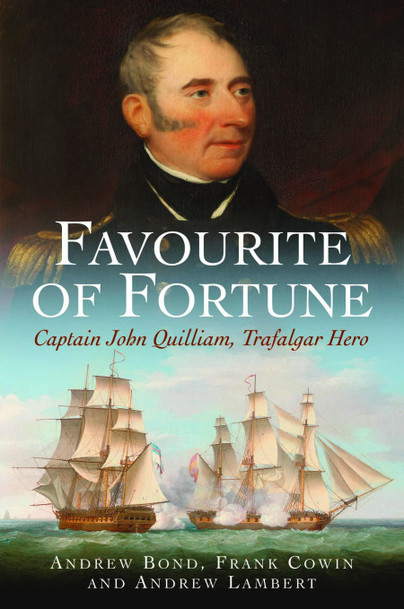Author Guest Post: Andrew Bond
On 11 October 1805, just ten days before the British and the combined French and Spanish fleets clashed off Cadiz, the Admiralty issued an order bringing the nautical day in line with its civil counterpart. Since time immemorial the day at sea had run from midday to midday, 12 hours ahead of the civil day running from midnight to midnight. Thus entries in the log for the afternoon or PM on a particular day precede entries for the morning or AM on that day and 1 PM on the afternoon of, say, 21 October at sea is equivalent to 1 PM on 20 October on shore. If naval historians and their readers find it confusing today, imagine the confusion the change must have caused 216 years ago.
With dispatches taking some two weeks or more to reach the fleet, the Admiralty order did not arrive until after 21 October and the battle was fought under the old system. Indeed it seems likely that commanders were given some latitude in deciding when to implement the change and almost certainly chose to do so when in harbour. As her master Thomas Atkinson’s log reveals, the change had not been made on Victory before she left Gibraltar bearing Nelson’s body back to England on 4 November and Quilliam himself, by then commanding the bomb vessel Aetna, didn’t implement it in his own log until 16 December.
The fact that the order had not arrived before the battle does not mean, however, that those most directly affected – the midshipmen and master’s mates most often tasked with writing up captains’, masters’ and senior lieutenants’ logs – were not aware of the imminent change. Indeed for them it foreshadowed an upheaval at least as profound as, for example, the transition from the Julian to the Gregorian calendar more than fifty years earlier. Nearer to our own time, the introduction of decimal currency, metrication and the switch from Fahrenheit to Centigrade temperatures all give some idea of the potential confusion.
That seems to be the most likely explanation for the serious errors in the pages covering the battle in the log Quilliam kept as Victory’s First Lieutenant. They start a week earlier when Monday 14 October, the correct date, is followed by Tuesday 16 October. An attempt is then made to get the log back in step when Sunday 21 October, which was in fact a Monday, is followed by Tuesday 22 October. The log was almost certainly not written up by Quilliam, as was common practice. Extraordinarily, given the momentous events of those two days, neither Quilliam himself nor Captain Hardy, both of whom signed it off when Quilliam left the ship a few days later, seem to have noticed the error. None of that, however, in any way detracts from the dramatic impact of those four pages as presented in the following transcript in which the original spelling, capitalisation and punctuation – or lack of it – are preserved:
October
Sunday 21
P.M. Light Breezes and Squally with Rain at 2 taken aback. Came to the wind on the Starboard Tack. At 4 wore Ship up topgallant Yards Look out Ships making Signals of the Enemy’s Positions. at 8.40 wore Ship at 12 Ditto Wr at 4 wore Ship at 6 observed the Enemy bearing EbS10 or 11 miles. Bore up to the Eastwd out all Reefs Top Sails set Steering Sails & Royals, cleared for Quarters, at 8 Light Breezes and cloudy Body of the Enemy’s Fleet EbS 9 or 10 miles, still steering for the Enemy’s Van the Royal Sovereign & her Line of Battle steering for the Centre of the Enemy’s Line. The Enemy’s Line extending about NNE to SSW. At 11.40 the Royal Sovereign commenced firing on the Enemy, they having begun on her at 11.30.
Tuesday 22
P.M. Light Airs and cloudy, standing towards the Enemy’s Van with all Sail sett. At 4 minutes past 12 opened our fire on the Enemy’s (illegible) in passing down their Line at 12.20 in attempting to pass through their Line, fell on board the 10th & 11th Ships, When the Action became General, about 1.15 Admiral The Right Honble Lord Visct. Nelson K.B. etc and commander in Chief was wounded in the Shoulder at 1.30 the Redoubtable having struck her Colors, we ceased firing our Starboard Guns, but continued engaged with the Santissima Trinidada and some of the Enemy’s Line on the Larboard side. Observed the Temeraire between the Redoubtable and another strange Ship of the Line, both of which had struck. The Action continued general until 3 O’Clock when several of the Enemy’s Ships around us had struck, observed the Royal Sovereign with the loss of her Main and Mizen Masts and several of the Enemy Ships around her dismasted. At 3.30 observed 4 sail of the Enemy’s Van tack and stand along our Wr. Line to Windward, fired our Larboard Guns at those they would reach at 3.40 made the Signal for our Ships to keep their wind and engage the Enemy’s Van coming along our Weather Line, at 4.15 the Spanish Rear Admiral to Windward struck to some of our Ships which had tacked after them, observed one of the Enemy’s Ships blow up and 14 sail standing towards Cadiz and 3 standing to the Southward, partial firing continued until 3.40 when a Victory having been reported to the Admiral Right Honble Lord Visct Nelson KB etc and Commander in Chief, he died of his wounds. At 5 the Mizen Mast fell about 10 feet above the Poop, the lower Masts Yards & Bowsprit crippled, rigging and Sails very much cut, the Ships around us very much crippled, several of our Ships pursuing the Enemy to Leeward Saw Vice Adm Collingwood’s flag flying on board HMS Euryalus and some of our Ships taking possession of the Prizes, struck TopGt. Masts got up runners and Tackles to secure the Masts, empd clearing the Wreck of the Yards & Rigging wore Ship & sounded in 32 fms sandy Bottom, stood to the Southward under the remnants of Foresail and Maintopsail, sounded from 13 to 19 fms at 2 wore Ship At Day Light saw our Fleet & Prizes 43 Sail, still closing with them. At 6 Cape Trafalgar bore SEbE 4 or 5 Leagues, 6.30 saw 3 of the Enemy’s Ships to Leeward standing towards Cadiz. Fresh Breezes and Cloudy Employed Knotting the Fore and Main Rigging & fishing and securing the Lower Masts, struck the Fore topmast for a Fish for the Foremast which was very badly wounded, at Noon fresh Breezes and hazy

…………………………………………………………………………………….

Favourite of Fortune is available here.

